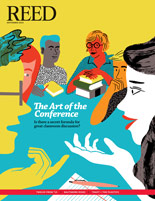
IRIS login | Reed College home Volume 94, No. 3: September 2015
Eliot Circular
Digital Pioneers Help Reed Design CS Program
A formidable array of computing brainpower converged on campus this spring to help Reed think through a long-awaited computer science (CS) program.
The digital elders represented a full spectrum of computing expertise: mathematicians, cryptographers, AI gurus, network wizards, codeslingers, and technology innovators, all focused on a fascinating problem—how Reed can build a computer science program that dovetails with its distinctive mission.
Reed has a long and proud tradition of computing, but has never had a CS department or a CS major. Computing is currently offered through the mathematics department, but students’ ravenous intellectual appetite for the subject is overtaxing department resources. Since 2007, the number of students enrolled in the introductory CS course has soared from 34 to 102. The college has recently created a CS concentration in mathematics and launched a Software Design Studio to give students more hands-on coding experience.
“The demand for computer science among Reed students is immense,” said President John Kroger.
Reed is seeking to raise $5 million to expand the curriculum, establish a major, and hire two new professors.
Prof. Jim Fix [mathematics 1999–] outlined Reed’s current curriculum and sketched out some possibilities for expansion, including courses on artificial intelligence, interface design, cryptography, and quantum computation. “Reed has an embarrassment of riches,“ Prof. Fix said. “We have great students. They’ll be very dangerous given the breadth and rigor of Reed’s education.”
The digerati shared some striking insights about how to design a strong CS program.
Ivan Sutherland invented the pioneering CAD system Sketchpad, ran the Information Processing Techniques Office for DARPA, and founded the CS program at Caltech. “When I started that program, I got some good advice,” he said. “They told me, ‘You’re too small to do everything.’ And I suggest that’s good advice for Reed.”
Nancy Groschwitz ’74 majored in psychology and paid no attention to computers until she got to grad school, where she taught herself how to program the PDP-8s and went on to become a software developer at Apple. She is passionate about boosting the number of women in computing. “I’m here to make a little noise, talk to people, and see if Reed can help change that,” she said.
Peter Norton ’65, the author of Norton Utilities, emphasized the importance of aesthetics of computing. “Elegant coding is faster and more reliable,” he said. “And we know that aesthetics matter in interface design. So let’s stir art, art history, and graphic design into our computer science major.”
Other digerati included Geoff Baldwin ’62, retired software engineer for Standard Oil Company of California; David Goldschmidt ’65, research consultant, former VP for research for Edgestream Partners; Bob Morris ’65, biodiversity informatician, Harvard; Alan Borning ’71, professor of CS at UW; Don Helfgott ’74, cofounder of Inspiration Software; John Fine ’82, retired program manager, Microsoft; Dayne Freitag ’86, program director, Artificial Intelligence Center, SRI International; Lennon-Day Reynolds ’03, technologist-in-residence for Reed’s Software Design Studio; Jacqueline Freeman and Layton Freeman, cofounders, Hedgemetrix; Steve Romero, founder of Critical Path Software; Rico Mariani, software engineer, Microsoft; David Walter, cofounder of Aldus Corporation; Kurt DelBene, senior executive at Microsoft and Healthcare.gov; and Ed Lazowska, professor of CS and engineering at the University of Washington.

LATEST COMMENTS
steve-jobs-1976 I knew Steve Jobs when he was on the second floor of Quincy. (Fall...
Utnapishtim - 2 weeks ago
Prof. Mason Drukman [political science 1964–70] This is gold, pure gold. God bless, Prof. Drukman.
puredog - 1 month ago
virginia-davis-1965 Such a good friend & compatriot in the day of Satyricon...
czarchasm - 4 months ago
John Peara Baba 1990 John died of a broken heart from losing his mom and then his...
kodachrome - 7 months ago
Carol Sawyer 1962 Who wrote this obit? I'm writing something about Carol Sawyer...
MsLaurie Pepper - 8 months ago
William W. Wissman MAT 1969 ...and THREE sisters. Sabra, the oldest, Mary, the middle, and...
riclf - 10 months ago